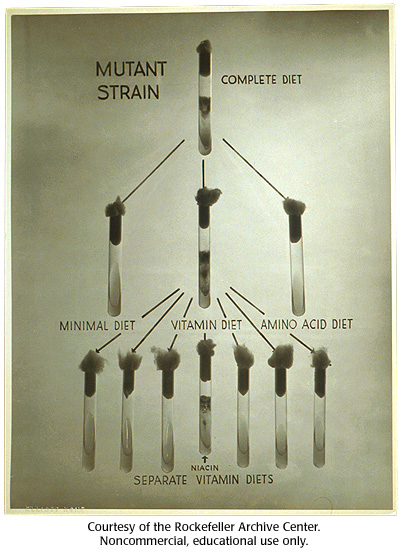Gallery 16: Neurospora mutants laid out to show the experimental design.

Neurospora mutants laid out to show the experimental design.
neurospora, experimental design, mutants
- ID: 16363
- Source: DNALC.DNAFTB
Related Content
16360. Animation 16: One gene makes one protein.
George Beadle and Edward Tatum present their experiments with Neurospora bread mold.
16395. Animation18: Bacteria and viruses have DNA too.
Joshua Lederberg worked with bacterial genetics while Alfred Hershey showed that DNA is responsible for the reproduction of new viruses in a cell.
16372. Biography 16: Edward Lawrie Tatum (1909-1975)
Edward Tatum and George Beadle used Neurospora to prove that "one gene makes one protein." Tatum also had a role in starting bacterial genetics.
16366. Gallery 16: Beadle and assistant in the Neurospora storeroom at Stanford, 1949.
Beadle and assistant in the Neurospora storeroom at Stanford, 1949.
16373. Problem 16: One gene makes one protein.
Test understanding of synthesis pathways with mutant Neurospora.
16263. Chromosomes carry genes.
DNAFTB Animation 10:Thomas Hunt Morgan describes his discoveries using fruit flies.
16418. Biography 18: Joshua Lederberg (1925-2008)
Joshua Lederberg discovered bacterial recombination and started a new field of research.
16298. Biography 11: Calvin Blackman Bridges (1889-1938)
Calvin Bridges was a student of Thomas Hunt Morgan. Bridges advanced the theory of chromosomal non-disjunction, and did a lot of work on chromosomal banding patterns.
11018. H. Laughlin's letter to C. Holmgren recommending C. Davenport for Nobel Prize
H. Laughlin's letter to C. Holmgren recommending C. Davenport for Nobel Prize
16097. Bz Mutants
Wildtype corn, bz-stable, and bz-mutable mutants.












